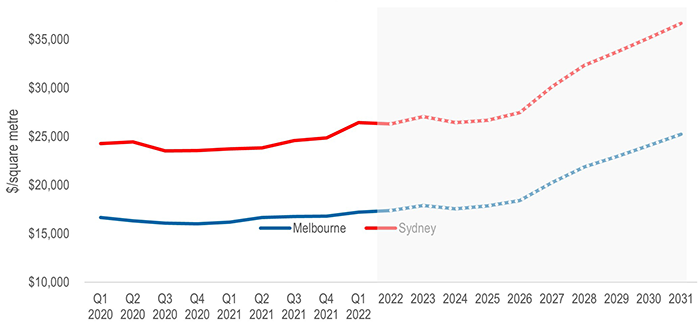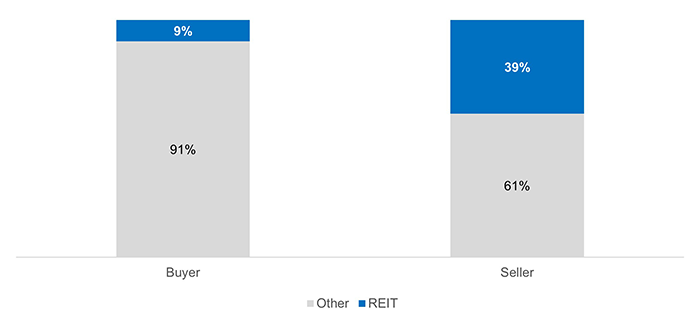A look at what transaction activity suggests for the future of office
So here’s the conundrum: if workers are only present in their offices a few days a week and an investment into commercial office buildings will surely suffer as a result, why has transaction activity remained robust?
For income investors seeking a reliable, attractive income stream, understanding the dichotomy between widely held beliefs and on-the-ground data is central to understanding the opportunities in the office sector.
It has long been our view that the office was not dead, explained in our three-part series published between June and November last year. While we acknowledged the cyclical impacts of declining economic growth induced by the pandemic, we felt localised supply and demand interactions would be the major driver of office investment returns in the immediate term.
As the pandemic took hold in early 2020, Australia’s office workers were thrust into the unknowns of working from home (WFH). Many of our central business districts became ghost towns as a result, with many office workers enjoying the freedom of WFH and possibly even more so not having to battle through the daily commute. Questions regarding the financial viability of the office sector as an investment class quickly followed.
In October last year, the Financial Review published The big office return is underway – and it’s filled with uncertainty. More recently, smh.com.au questioned the benefits of a return to the office and wrote about why bosses are giving up on the five-day week. Many CEOs also now accept that the hybrid home/office model where staff gather together in their workplaces two or three days a week is a permanent change to their operations.
This has played out as we expected. While there has been a softening in some key office operating metrics, including vacancy rates, incentive levels and rental growth, especially in the prime market CBDs of Sydney and Melbourne, there hasn’t been any material decline in the level of investor demand for office assets.
In other words, the narrative carried by the mainstream media that the office market is set for structural decline is in direct contrast with the quantum of capital being deployed to the sector. All the evidence suggests that post-pandemic, high-quality office assets located in major urban localities remain central to the investment activity of major institutions.
There are two ways to support this proposition with evidence, firstly by an examination of transactions activity and then by scrutinising the capital values at which deals have occurred.
Activity in transaction markets
Commercial real estate transaction volumes across all major sectors bounced back strongly in 2021, reflecting pent-up investor demand and a desire to access the real asset qualities of the sector.
On a rolling 12-monthly basis, the total value of all deals to March 31, 2022, totalled $53.9 billion, according to Cushman & Wakefield. This exceeded the previous record of $51.9 billion set in calendar 2021. Industrial spaces (31% per) and office property (29%) accounted for almost two-thirds of the total.1
With $6.5 billion in transactions in the first quarter of 2022 according to Cushman & Wakefield, Australia’s commercial real estate investment sector also had its strongest start to a calendar year.1
This figure surpassed the previous first-quarter record of $6.3 billion set in 2018. The first three months of 2022 were also notable in that the office investment market accounted for 42% of all commercial real estate deals, up from 14% in the December 2021 quarter.1
The future looks even more encouraging. Cushman & Wakefield’s head of research, John Sears, believes the outlook is “increasingly positive for Australian commercial real estate markets, as local investments continue to provide attractive returns compared to many fixed-interest and overseas investments”.1
If the future of the office was as dim as the media portrayed, these transaction values would be far lower. Instead, they’re at record levels.
Prime capital values
Now, what about capital values? JLL estimates that for Sydney’s CBD, prime capital values have increased by about 9% from the start of the pandemic while Melbourne has experienced a positive, albeit lower, increase of about 3% over the same period.2
Recent transactions suggest continued growth in activity within these markets, a view concurrent with that of industry researchers JLL, who’s analysis suggest that during the first quarter of 2022, capital value forecasts for all capital cities were revised upwards, Perth being the exception.
Additionally, JLL forecast capital growth in prime office across all capital cities through to 2024. Looking at the major prime Sydney and Melbourne CBD office markets in isolation, the graph below indicates a positive outlook for capital values.
JLL CBD prime capital value indicator

Nationally, however, there remains some significant office deals yet to complete. This will test pricing levels and buyer depth, especially with interest rates rising from their ultra-low levels of 2020. We are looking especially closely at any implications for asset transaction pricing which might emerge on account of factors like upward pressure on debt funding costs and broader concerns about inflationary expectations and the implications of geopolitical conflict.
The bigger picture, though, has already revealed itself. The office sector is very much alive and kicking. Instead of the pandemic killing the office, it has demonstrated the resilience and popularity of well-leased prime office properties.
There is now widespread recognition of the value of teams gathering in one physical location. While putting a figure on the value of the kind of collaborations and spontaneous connections physical proximity with colleagues engenders, we know companies pay a price when it doesn’t happen.
We also now know that prime office assets with relatively higher levels of amenity are best positioned for corporate tenants to attract and retain staff in a competitive labour market.
And finally, we know that commercial property investors increasingly recognise these facts.
The view that high-quality office assets with strong tenant covenants, lease term coverage and ESG credentials are likely to be winners over the medium and longer term is now widespread. It is also a view that we have held throughout the pandemic that has dictated our portfolio decisions in the sector.
AREITs are taking these lessons aboard and adapting their portfolios accordingly. Taking advantage of healthy pricing and capital demand, AREITs have sold approximately $6 billion in assets since the pandemic began and at an average premium of 2% to book value3.
This is consistent with the above themes. AREITs are consolidating their portfolios and recycling capital into their growing development pipelines. This is an ‘out with the old, in with the new’ approach to office investment and capital allocation, designed to position portfolios to benefit from the themes detailed above that will underpin future returns for investors.
Sydney and Melbourne office transactions 2021-22

This is consistent with the approach we’ve used throughout the pandemic in the APN AREIT Fund. It is already clear that the office is not dead. Now there is growing evidence that well-located, prime assets will be the most in demand, delivering attractive, reliable returns to their investors.
For investors in commercial office property, a highly selective approach based on quality is already paying dividends. In the years ahead, we expect those dividends to increase.
Broaden your income horizons
APN Real Estate Securities (RES) is a specialist investment manager that actively manages portfolios of listed property securities. Since inception in 1998, our deep understanding of real estate and “property for income” philosophy, together with a highly disciplined investment approach has been the backbone of our performance. Click here to discover more.

2 topics

